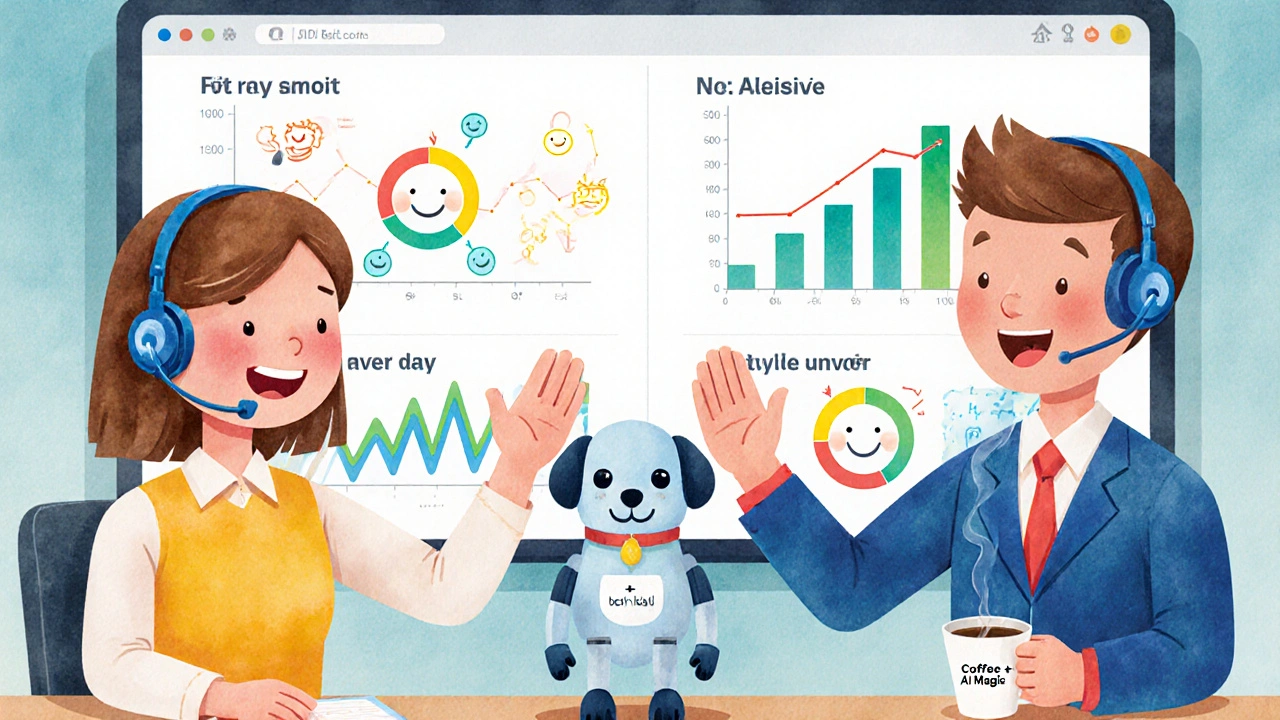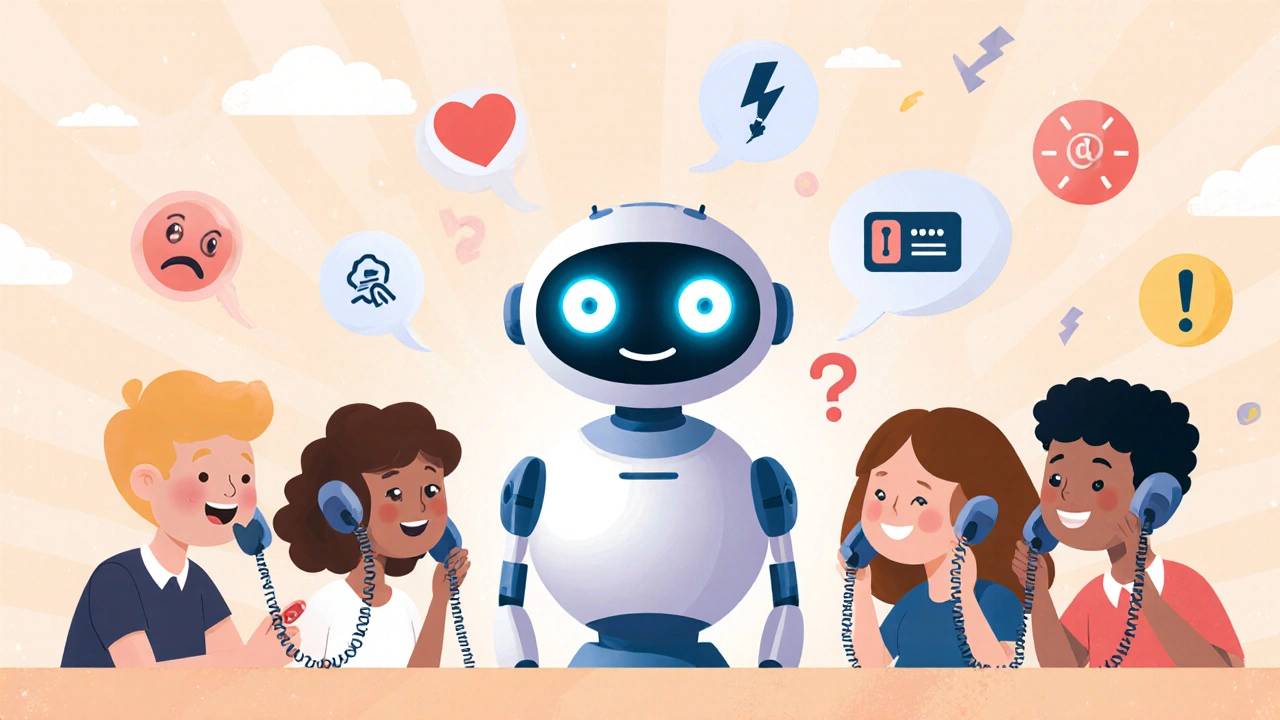By 2025, if your contact center still relies on basic IVR menus and rigid call flows, you’re already behind. The days of pressing 1 for sales, 2 for support, and then waiting 12 minutes are fading fast. Today’s customers expect answers-fast, accurate, and personalized-without having to repeat themselves. That’s where AI and machine learning integration in call handling comes in. It’s not science fiction anymore. It’s the new baseline for customer service.
How AI Actually Handles Calls Today
Modern AI call systems don’t just play pre-recorded messages. They listen, understand, and respond like a human would-only faster and without fatigue. At the core are three technologies working together: Natural Language Processing (NLP), Machine Learning (ML), and Robotic Process Automation (RPA).NLP engines like Google’s Dialogflow CX and Amazon Lex interpret what customers say, not just keywords. They catch intent, tone, and even context. If someone says, “I can’t believe my bill went up again,” the system doesn’t just route them to billing. It recognizes frustration, flags the sentiment, and prepares the next step-maybe offering a discount or connecting them to a specialist.
Machine learning learns from every interaction. The more calls it handles, the smarter it gets. A system trained on 50,000+ past conversations can predict whether a customer is likely to hang up, what issue they’re really struggling with, and which agent has the best track record of resolving similar cases. That’s not guesswork. That’s data-driven routing.
RPA handles the boring stuff automatically: updating account details, sending invoices, scheduling appointments, or resetting passwords. These are tasks that used to take agents 3-5 minutes each. Now, AI does them in under 10 seconds-with 99.8% accuracy, according to GoodCall’s 2025 case studies.
What This Means for Your Customers
Customers aren’t just happier-they’re more loyal. In 2025, 84% of callers say they appreciate reduced hold times when AI handles the first touchpoint. And it’s not just speed. Personalization matters. Systems now use 347 data points per interaction: past purchases, previous complaints, browsing behavior, even time of day. That means when you call about a billing error, the AI doesn’t ask, “What’s your account number?” It already knows. It says, “I see your last payment was late due to a missed due date. Would you like to set up a payment plan?”First-contact resolution rates jumped 15-25% with AI routing. That’s because the system doesn’t just match you to any agent. It matches you to the *right* agent. Based on your tone, issue history, and predicted outcome, it sends you to someone who’s handled similar cases successfully before. This predictive routing outperforms traditional skill-based routing by over 31%.
And when the AI can’t solve it? It doesn’t dump you into a black hole. It gives the human agent a full summary: “Customer called about overcharge. Sentiment score: -0.82. Already tried self-service. Previous complaint in March. Suggested resolution: refund $42 + loyalty credit.” The agent doesn’t waste time catching up. They start helping immediately.

Where AI Still Falls Short
Let’s be clear: AI isn’t replacing humans. It’s making them better. But it still struggles in key areas.When a customer is angry-really angry-AI accuracy drops to 68.2%. If someone says, “I’m done with your company,” the system might still try to upsell a plan. That’s a disaster. Human empathy can’t be coded. Stanford’s Human-Centered AI Institute found 41% of customers feel dehumanized when AI misses emotional cues.
Complex issues? AI fails too. For multi-step technical problems-like a router that won’t sync with a new modem-the success rate is only 43.7%. Humans? 82.3%. AI can’t yet reason through layered problems the way a seasoned technician can.
And multilingual calls? If someone switches between English and Spanish mid-sentence (code-switching), accuracy drops to 76.4%. Most systems still assume one language per call. That’s a problem in diverse markets.
There’s also the “AI loop trap.” Reddit users shared dozens of stories where the system kept asking the same question, misinterpreting frustration as confusion. “I said I want to cancel, and it kept asking if I wanted to upgrade,” wrote one user. That’s not intelligence. That’s poor design.
Cost, Implementation, and Who’s Leading
Implementing this isn’t cheap. For a mid-sized contact center, expect to pay between $150,000 and $2.5 million. The biggest costs? Training the AI on your data, integrating with your CRM (Salesforce, Zendesk, Dynamics), and training your team.Most successful deployments take 6-9 months. The first 4-6 weeks are spent mapping every possible customer interaction. Then, data scientists and call center veterans work together to train the AI on real transcripts-not hypothetical scenarios. You need at least 50,000 past calls to start. No shortcuts.
And here’s the kicker: 22% of your budget should go to change management. Agents aren’t just users-they’re partners. If they feel threatened, they’ll resist. The best companies run pilot programs with 15-20% of calls, train agents on how to use AI tools, and celebrate wins: “Maria reduced her after-call work by 65% this week because the AI wrote her summaries.”
The market is dominated by five players: Amazon Connect (22%), Genesys (18%), Cisco (13%), Five9 (7%), and Nice inContact (3%). Cisco’s documentation gets top marks for clarity. InContact’s? Not so much. If you’re a small business, the cost is still a barrier. Only 34% of SMBs have adopted AI call handling-mostly because they don’t have the data or staff to train it.

What’s Next? Proactive Service and Agentic AI
The next wave isn’t about answering calls. It’s about preventing them.Leading companies are using AI to predict issues before customers even notice. If your internet speed drops below 10 Mbps for three days straight, you might get a text: “We noticed your connection is slower than usual. Would you like us to reset your modem?” That’s proactive service. It’s growing at 47% year-over-year.
And then there’s agentic AI-systems that handle entire customer journeys without human help. For simple tasks like changing a delivery address or renewing a subscription, these bots can complete the whole process end-to-end. Adoption is still low (28%), but it’s growing fast.
By 2027, Gartner predicts contact centers without AI routing will see 23% higher customer churn. That’s not a risk. That’s a business threat.
Final Thought: It’s Not About Replacing People
The goal isn’t to eliminate agents. It’s to free them from the grind. Right now, agents spend 60% of their time on repetitive tasks: looking up info, typing notes, transferring calls. AI cuts that to 20%. That means agents can focus on what matters: solving hard problems, calming upset customers, building relationships.One agent on Reddit put it best: “The AI doesn’t replace me. It lets me be the agent I wanted to be.”
AI call handling isn’t optional anymore. It’s infrastructure. The question isn’t whether you should adopt it. It’s how fast you can do it right-without losing the human touch that keeps customers coming back.
Can AI handle customer complaints effectively?
AI can handle routine complaints like billing errors or service outages with 94% accuracy. But when emotions run high-like a customer threatening to cancel-AI accuracy drops to 68%. These situations need human empathy. The best systems flag emotional distress and instantly transfer the call to a live agent.
How much does AI call handling cost?
Implementation costs range from $150,000 for small teams to $2.5 million for large enterprises. The biggest expenses are data preparation, CRM integration, and agent training. Ongoing costs include cloud hosting, model updates, and compliance (like GDPR), which can add 15-20% to the total.
Do I need a big data team to use AI call handling?
You don’t need to hire a data science team, but you do need access to historical call data-ideally 50,000+ recordings. Most vendors offer managed services that handle training for you. What you do need is a contact center manager who understands workflows and can work with the vendor to define what success looks like.
Will AI replace call center jobs?
No-it’s changing them. By 2025, AI will shift 65% of agent time away from repetitive tasks and toward complex problem-solving and emotional support. Agents aren’t being fired. They’re being upskilled. Companies that invest in training see 37% higher customer satisfaction and lower turnover.
Can AI work with my existing CRM?
Yes. Leading AI platforms integrate with Salesforce, Zendesk, Microsoft Dynamics, and HubSpot via RESTful APIs. The challenge isn’t compatibility-it’s data quality. If your CRM has incomplete records or messy entries, the AI won’t work well. Clean data is non-negotiable.
What’s the biggest mistake companies make when implementing AI call handling?
Trying to automate everything at once. The most successful deployments start small: one or two high-volume, low-complexity tasks like appointment scheduling or balance checks. They test, measure, and improve before expanding. Rushing leads to frustration-for customers and agents alike.
